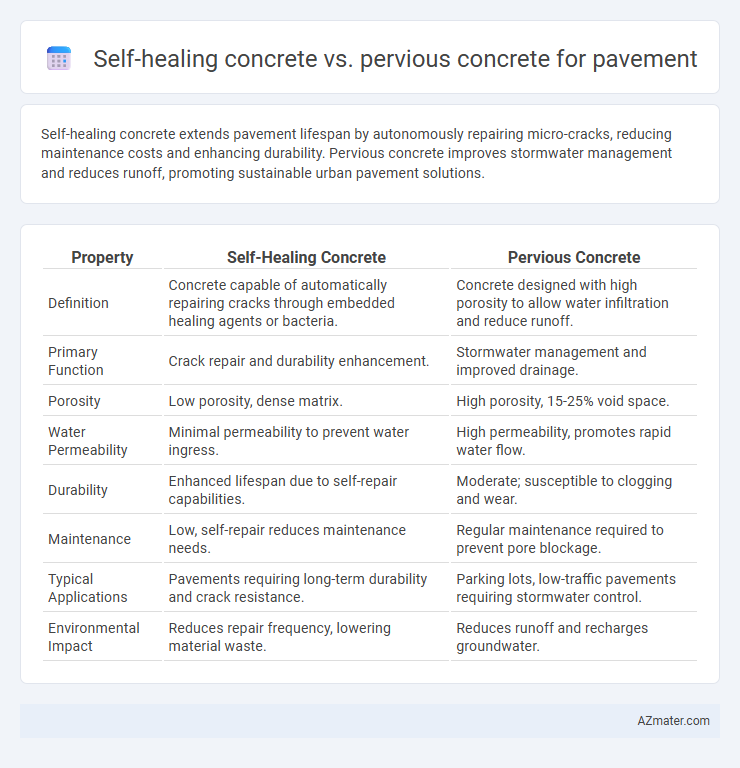Self-healing concrete extends pavement lifespan by autonomously repairing micro-cracks, reducing maintenance costs and enhancing durability. Pervious concrete improves stormwater management and reduces runoff, promoting sustainable urban pavement solutions.
Table of Comparison
| Property | Self-Healing Concrete | Pervious Concrete |
|---|---|---|
| Definition | Concrete capable of automatically repairing cracks through embedded healing agents or bacteria. | Concrete designed with high porosity to allow water infiltration and reduce runoff. |
| Primary Function | Crack repair and durability enhancement. | Stormwater management and improved drainage. |
| Porosity | Low porosity, dense matrix. | High porosity, 15-25% void space. |
| Water Permeability | Minimal permeability to prevent water ingress. | High permeability, promotes rapid water flow. |
| Durability | Enhanced lifespan due to self-repair capabilities. | Moderate; susceptible to clogging and wear. |
| Maintenance | Low, self-repair reduces maintenance needs. | Regular maintenance required to prevent pore blockage. |
| Typical Applications | Pavements requiring long-term durability and crack resistance. | Parking lots, low-traffic pavements requiring stormwater control. |
| Environmental Impact | Reduces repair frequency, lowering material waste. | Reduces runoff and recharges groundwater. |
Introduction to Innovative Pavement Materials
Self-healing concrete incorporates microcapsules or bacteria that autonomously repair cracks, enhancing pavement durability and reducing maintenance costs. Pervious concrete features a porous structure that allows water infiltration, improving stormwater management and mitigating urban flooding. Both materials represent innovative pavement solutions addressing durability and sustainability challenges in modern infrastructure development.
What is Self-Healing Concrete?
Self-healing concrete is an innovative construction material embedded with microcapsules or bacteria that activate to repair cracks autonomously, enhancing durability and reducing maintenance costs in pavement applications. This technology extends pavement lifespan by sealing fissures through calcium carbonate deposition or polymer formation, effectively mitigating water infiltration and structural degradation. Compared to pervious concrete, which primarily focuses on permeability and stormwater management, self-healing concrete emphasizes structural integrity and longevity by addressing cracking at the source.
Understanding Pervious Concrete Technology
Pervious concrete technology enhances pavement sustainability by allowing water to infiltrate through its porous structure, reducing stormwater runoff and improving groundwater recharge. Unlike traditional concrete, pervious concrete consists of a network of interconnected voids achieved by using little to no fine aggregates, which enables rapid drainage while maintaining adequate strength for light-traffic pavements. Self-healing concrete, on the other hand, incorporates bacteria or microcapsules that precipitate calcium carbonate to seal cracks autonomously, but it does not primarily address permeability or water management like pervious concrete does.
Key Differences Between Self-Healing and Pervious Concrete
Self-healing concrete incorporates microcapsules or bacteria that activate upon cracking, autonomously repairing damages and enhancing durability, whereas pervious concrete is designed with high porosity to allow water infiltration, reducing surface runoff and improving stormwater management. The primary difference lies in functionality: self-healing concrete focuses on extending pavement lifespan by mitigating crack propagation, while pervious concrete prioritizes environmental benefits through permeability and groundwater recharge. Both materials offer innovative solutions for sustainable pavement, with self-healing concrete optimizing structural integrity and pervious concrete enhancing hydrological performance.
Durability and Lifespan Comparison
Self-healing concrete significantly enhances pavement durability by autonomously repairing microcracks, reducing maintenance needs and extending lifespan beyond 50 years under typical traffic loads. Pervious concrete offers excellent water permeability, reducing surface runoff but tends to have lower compressive strength and a shorter lifespan, generally around 20-30 years in pavement applications. The superior crack resistance and prolonged structural integrity of self-healing concrete make it a more durable and long-lasting option compared to pervious concrete for pavements.
Environmental Impact and Sustainability
Self-healing concrete reduces maintenance frequency and extends pavement lifespan by autonomously repairing cracks, significantly decreasing resource consumption and carbon emissions over time. Pervious concrete enhances environmental sustainability by promoting natural groundwater recharge and reducing stormwater runoff, thus mitigating urban flooding and improving water quality. Both materials contribute to sustainable infrastructure, with self-healing concrete optimizing durability and pervious concrete improving ecological impact through water management.
Performance in Different Climate Conditions
Self-healing concrete offers improved durability and crack resistance in extreme temperature fluctuations and freeze-thaw cycles, reducing maintenance in cold and temperate climates. Pervious concrete enhances stormwater management by facilitating rapid drainage but may experience reduced structural integrity in regions with frequent heavy rainfall or freeze-thaw stress. The choice between self-healing and pervious concrete depends on climatic factors such as precipitation patterns, temperature extremes, and freeze-thaw frequency to optimize pavement performance.
Cost Analysis and Economic Feasibility
Self-healing concrete reduces long-term maintenance costs by autonomously repairing cracks, extending pavement lifespan despite higher initial material expenses compared to pervious concrete. Pervious concrete offers lower upfront costs and promotes stormwater management, yet may require more frequent repairs, increasing lifecycle expenses. Economic feasibility favors self-healing concrete in infrastructure demanding durability, while pervious concrete suits budget-sensitive projects prioritizing environmental benefits.
Maintenance Requirements and Longevity
Self-healing concrete significantly reduces maintenance requirements by automatically sealing cracks using embedded microcapsules or bacteria, prolonging pavement lifespan compared to traditional materials. Pervious concrete, designed for enhanced water permeability, requires regular vacuuming or pressure washing to prevent clogging and maintain functionality, potentially increasing upkeep frequency. While self-healing concrete offers superior longevity due to minimized structural damage, pervious concrete's durability depends on effective maintenance to avoid pore blockage and deterioration.
Choosing the Right Concrete for Pavement Applications
Self-healing concrete enhances pavement durability by autonomously repairing cracks, reducing maintenance costs and extending service life, ideal for high-traffic areas requiring longevity. Pervious concrete facilitates water drainage through its porous structure, effectively mitigating stormwater runoff and improving environmental sustainability in urban pavements. Selecting the right concrete depends on balancing the need for structural resilience against ecological benefits, with self-healing concrete suited for durability-focused projects and pervious concrete preferred for managing water permeability.

Infographic: Self-healing concrete vs Pervious concrete for Pavement
 azmater.com
azmater.com